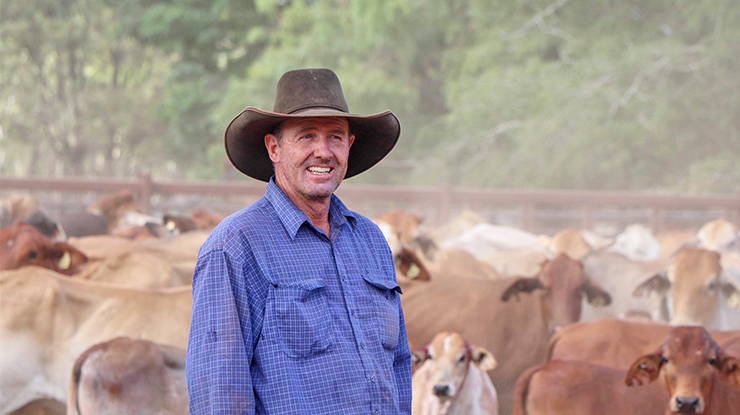
The Lethbridge family (Lux and Linley and son Russell and wife Donna) own Werrington Station, 19,500ha of mainly eucalypt woodland approximately 125km south-east of Georgetown.
Werrington Station carries most of the breeders (2,500 out of a total herd of 9,000–10,000 head) but is run in conjunction with 'Rainmore', 28,000ha of buffel grass on brigalow country south of Alpha, and other agistment on forest and downs country.
Werrington (average rainfall of 700mm) has soils of varying fertility. Phosphorus levels are generally deficient: sandy country at 2–3mg/ kg, decomposed granites 3–4mg/kg, red earths 2–4mg/kg, black soils 3–6mg/kg and Goldfield soils 7–8mg/kg.
Each paddock is spelled for 4–5 months over the wet season every second year, with weaner paddocks spelled every year, and no burning for over 30 years. Some country has been oversown with Seca and Verano stylo and Wynn Cassia.
Herd management
Breeders have been control-mated to drop calves over the September to November period. All animals are vaccinated for botulism.
Supplementation
Breeders get both dry and wet season supplement. After the first frosts, weaner heifers get six months of the dry season supplement of M8U plus 1% P and 8% copra meal.
Wet season phosphorus supplement (9.1% P) is made up of 44% Kynofos™, 35% salt, 8% urea, 7% limestone, 4% GranAm™, 2% sulphur with 0.5% Rumigro™ vitamin and mineral mix, and costs $865/tonne delivered (2012). Target intakes are 7–8g P/head/day for breeders and heifers and 4g/head/day for steers. When fed for 100 days over the wet season, this supplement costs $7–8 per breeder.
"In earlier days, some phosphorus was fed haphazardly during the wet season. Later we decided to get serious on phosphorus feeding and stopped trying to mix our own and got our recipe commercially mixed, and concentrated on getting recipes and intakes right," Russel said.
"We soon noticed a 15–20kg advantage in the dressed weight of cull cows and a 15% branding advantage across the Werrington cows.
"Feeding phosphorus maximises weight gains of the breeders over the wet resulting in higher condition scores at calving. To maintain branding rates, our cows must calve in condition score 3 or above. Phosphorus feeding over the wet is the key to achieving these condition scores.
"We now put out wet season phosphorus in half-tonne fertiliser bags," Russell said.
"All supplement is put out before the wet, away from permanent waters.
"We estimate the net benefit of phosphorus is about $130,000 a year without counting ease of mustering and the benefits of quieter cattle."
Werrington economic modelling
Without phosphorus supplementation, weaning rates (except for first-calf heifers) are assumed to be reduced by 15%, breeder mortality rates increase from 1.5% to 3%, only a portion of empty cows can be sold, and cow culling age has to be increased from 10 to 11 years. Mature cow weights (paddock and slaughter) are reduced by 40kg, and calf weight at five months is reduced from 150 to 130kg. Weaners are still supplemented.
These assumptions for the effect of P, especially its impact on breeder mortalities, may be conservative. No allowance has been made for the benefits of reduced mustering cost.
Net turn-off is calculated as total sales less purchases (bulls), divided by cattle carried for the whole year. The 'Breeders' columns in the table below can be compared since both are modelled to turn off weaner steers.
Breeders (no P) |
Breeders (+ P) |
|
|---|---|---|
Adult equivalents |
6,635 |
6,635 |
Breeders mated |
4,763 |
4,129 |
Calves weaned |
2,970 |
2,993 |
Weaning % |
62% |
72% |
Net turn-off % |
37% |
41% |
Steer turn-off age |
Weaners |
Weaners |
Steer price (net) |
$250 |
$289 |
Female price |
$499 |
$546 |
Husbandry cost/AE |
$32 |
$42 |
Gross margin/AE |
$116 |
$132 |
Total GM |
$767,750 |
$878,900 |
Table 1. Economic modelling across all properties showing benefits of feeding P supplement to breeders
Similar numbers of steers are available to transfer to the fattening property (half of 2,993 or 2,970 respectively), though the unsupplemented steers are lighter and this may affect the profit performance of the fattening property.
P supplementation increases breeder gross margin (GM) by $16.76/AE, or $111,150 overall.






